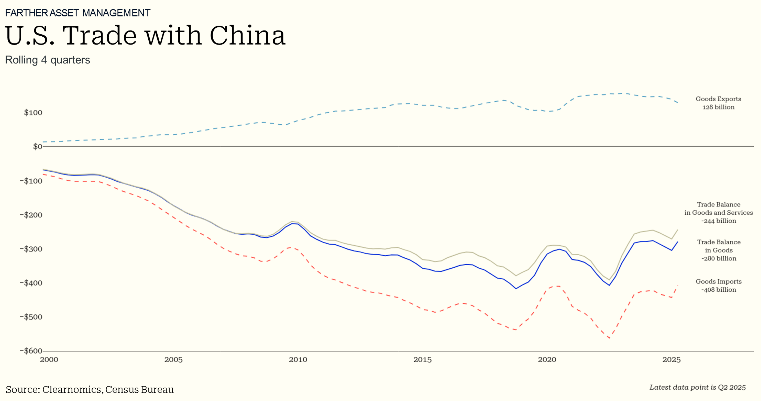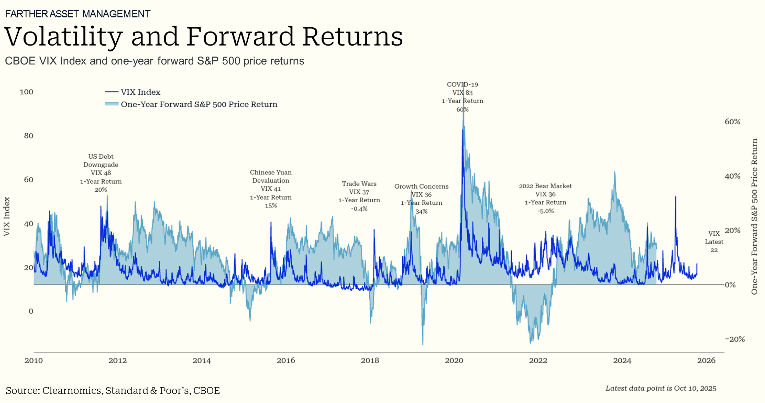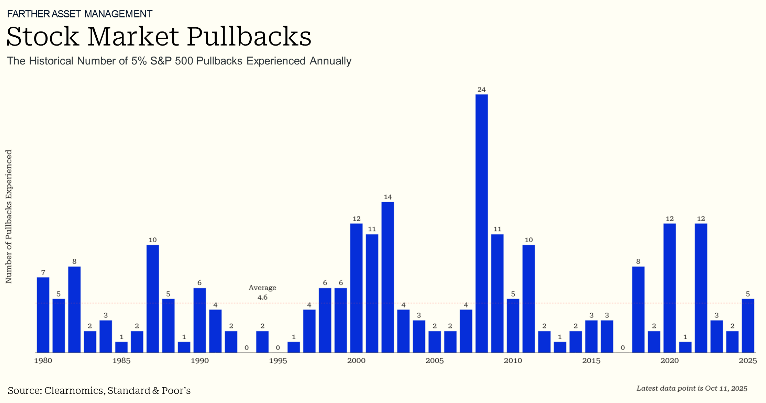
Market Volatility and Trade Tensions: Staying the Course During Uncertainty
October 13, 2025
Markets recently witnessed their steepest single-day drop since April, sparked by intensifying disputes between the United States and China regarding rare earth materials and trade policy measures. Though the sharp decline unsettled investors, markets rebounded quickly after the administration softened its rhetoric on trade matters. For those with long-term investment horizons, these fluctuations may feel familiar following a stretch of market stability.
Even with trade-related uncertainty throughout the year, market performance has been robust. The S&P 500, Nasdaq, and Dow have all posted double-digit percentage returns. Fixed income investments have also contributed positively to portfolios, with the Bloomberg U.S. Aggregate Index climbing 6.7%, marking an exceptionally strong period for bonds. International equity markets have surpassed domestic returns, with developed markets advancing 21.9% and emerging markets rising 27.0%. Given this backdrop, it's crucial not to allow one difficult trading session and accompanying negative news coverage to influence investment strategy.
Instead, market fluctuations should reinforce the understanding that near-term volatility is inherent to investing, while maintaining a long-term outlook continues to be fundamental to achieving financial objectives. Recognizing the factors behind market reactions and preserving appropriate portfolio diversification can help investors remain committed to their long-term plans.
Recent trade disputes and rare earth materials

The recent market turbulence stemmed from China's new limitations on rare earth metal exports, which prompted the administration to threaten an additional 100% tariff on Chinese imports beyond existing measures. This development extends the pattern of escalation and de-escalation that has generated uncertainty for both investors and corporations throughout the year. Encouragingly, the administration has since appeared to moderate these threats and suggested that diplomatic discussions could occur in the coming weeks.
What makes rare earth materials significant, and why have they become central to trade disputes? Unlike many imports to the United States, rare earth metals are predominantly produced by China. Although these elements are not actually scarce in geological terms, China has developed substantial extraction and refining infrastructure over several decades, far exceeding that of other nations. These materials are essential inputs for numerous advanced technologies, including smartphones, electric vehicles, batteries, defense systems, and sophisticated electronics.
These factors make rare earth materials among China's most powerful bargaining chips in trade negotiations and international relations with the United States and other countries. Estimates indicate that China currently accounts for roughly 70% of worldwide rare earth production and approximately 90% of refining capacity, creating supply chain vulnerabilities for the global economy. The United States maintains strategic reserves of rare earth materials and has issued directives to expand domestic production, though this transition will require considerable time.
Discussions surrounding rare earth materials represent just one element of the administration's broader trade strategy with China. As illustrated in the chart above, the United States continues to maintain a substantial trade deficit with China, and narrowing this gap while promoting domestic industry has been among the administration's policy priorities.
Outcomes thus far have been varied—while certain manufacturing operations have relocated to the United States and new capital investments have been announced, supply chain restructuring cannot occur instantaneously. Recent weakness in the labor market has added complexity: according to the August employment report, manufacturing jobs had decreased by 78,000 positions year-to-date.
For market participants, determining whether new tariff announcements should be interpreted literally or as negotiating tactics remains challenging. This uncertainty can trigger rapid changes in investor confidence and market dynamics. Therefore, avoiding knee-jerk reactions to news headlines and allowing situations to unfold while concentrating on longer-term developments is essential. This held true during the initial trade disputes in 2018 and 2019, and investors who reacted hastily earlier this year missed the rapid market rebound that followed.
Market volatility has increased following a calm period.

Recent market movements have elevated uncertainty and volatility levels. This development is understandable, given investor concerns about the market's forward price-to-earnings multiple of nearly 22.5x and questions regarding the durability of gains in artificial intelligence equities.
While understanding market drivers is valuable, historical evidence demonstrates that volatile periods frequently present the most attractive investment opportunities. Near-term concerns typically lead to improved valuations, which subsequently benefit long-term portfolios. The difficulty of investing during turbulent times is precisely why investors with the discipline to maintain their approach are compensated.
The accompanying chart illustrates the historical relationship between the VIX index, which measures equity market volatility, and subsequent twelve-month returns for the S&P 500. Historically, elevated VIX readings have frequently preceded robust forward returns, as these moments coincide with widespread investor apprehension that prevents market participation or triggers ill-timed selling. This pattern illustrates the detrimental effects of overreacting to market fluctuations.
Market performance has been strong despite negative sentiment

Although the 2.7% drop on October 10 ranked as the fourth-worst trading day of the year for the S&P 500, maintaining perspective remains important. The accompanying chart demonstrates that market corrections of 5% or greater occur frequently, even during years with positive returns. While this year has seemed volatile, the actual number of pullbacks has been typical relative to historical market behavior over the past 45 years. Indeed, markets have exceeded expectations this year, with the S&P 500 climbing 31.5% from its April "Liberation Day" trough and recording more than 30 new record highs year-to-date.
The message here is not that markets consistently advance without interruption, because they clearly do not. Rather, it's that episodes of market uncertainty are both normal and anticipated, and investors should always be prepared for short-term turbulence. Resisting the urge to fixate on every development that might disrupt markets is among the most critical factors in achieving long-term financial success.
The bottom line? Brief episodes of market volatility can be unsettling but represent normal, expected occurrences, particularly amid ongoing trade tensions between the United States and China. Historical evidence suggests that periods of elevated uncertainty, although uncomfortable, frequently create the most significant opportunities for disciplined investors.







